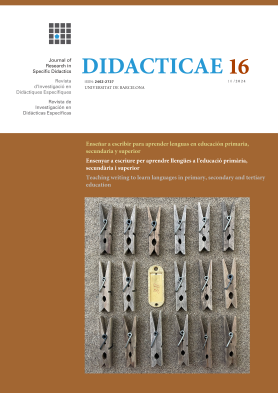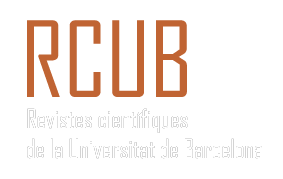Relaciones entre el uso y la reflexión metalingüística en una secuencia didáctica de gramática
Connections between the use of and metalinguistic reflection on temporality in a grammar didactic sequence
DOI:
https://doi.org/10.1344/did.45506Keywords:
grammar teaching, metalinguistic reflection, didactic sequences, interlingual contrastAbstract
In this study, we examine the metalinguistic reflection undertaken by a group of first-year secondary education students during their completion of a didactic grammar sequence with the objective of determining its potential impact on language learning and enhancement of written expression. The sequence is intended for students to reflect on the use of tenses and expressions of time to convey habituation in the past and present focusing on the contrast of the different curricular languages they study. Grammatical concepts are presented within learning situations and the sequence includes activities that prompt such reflection, drawing students’ attention to linguistic phenomena, and helping to name them and practicing their usage. Our research methodology is qualitative and responds to action research. The analysis of the texts written by the students indicated to what extent the systematization of learning and the construction of an incipient discourse on how language functions in a multilingual context was achieved. In addition, the analysis highlights the obstacles that were detected in these written productions, and the most significant differences between progress in language use and theoretical explanations of the language.
References
Abad, V. y Rodríguez Gonzalo, C. (2023). Cómo abordar la reflexión gramatical en el aula. Textos de Didáctica de la Lengua y la Literatura, 100, 33-38.
Bronckart, J.-P. y Schneuwly, B. (1991). La didactique du français langue maternelle: l’émergence d’une utopie indispensable. Education et Recherche, 13, 8-26.
Camps, A. (2000). Aprendre gramàtica. En A. Camps y M. Ferrer (Coords.), Gramàtica a l’aula (pp. 101-118). Graó.
Camps, A. (Comp.) (2003). Seqüències didàctiques per aprendre a escriure. Graó.
Camps, A. (2006). Secuencias didácticas para aprender gramática (SDG). En A. Camps y F. Zayas (Coords.), Secuencias didácticas para aprender gramática, 31-48. Graó.
Camps, A. (Coord.), Guasch, O. Milián, M. y Ribas Seix, T. (2005). Bases per a l’ensenyament de la gramàtica. Graó.
Camps, A. y Fontich, X. (2020). Introduction. En A. Camps y X. Fontich (Eds.), Research and teaching at the intersection. Navigating the territory of grammar and writing in the context of metalinguistic activity (pp. 29-43). Peter Lang.
Dolz, J. y Schneuwly, B. (1997). Géneros y progresión en expresión oral y escrita. Textos de Didáctica de la Lengua y de la Literatura, 11, 77-98.
Durán, C. (2010). Les competències i l’ensenyament de la gramàtica. Articles. Revista de Didàctica de la Llengua i la Literatura, 51, 36-50.
Elliot, J. (1993). El cambio educativo desde la investigación acción. Morata.
Garcia Vidal, P. (2018). Com s’aprenen les llengües en Secundària. Perifèric.
Gracida, Y., Bombini, G. y Jurado, F. (2024). El enfoque comunicativo de la lengua y la literatura en el contexto escolar en Latinoamérica. Textos de Didáctica de la Lengua y la Literatura, 103, 84-92.
Guasch. O. (2011). Plurilingüisme i formació lingüística dels escolars. En O. Guasch (Coord.), El tractament integrat de les llengües. (pp. 13-28). Graó.
Milián, M. (2012). El model de seqüència didàctica vint anys després. Un model vàlid per ensenyar a aprendre i per aprendre a ensenyar. Articles. Revista de Didàctica de la Llengua i la Literatura, 57, 8-21.
Milián, M. (2023). Leer y escribir. Algunas consideraciones sobre el discurso y el conocimiento lingüístico. Articles. Revista de Didàctica de la Llengua i la Literatura, 99, 22-30.
Ribas Seix, T. (2012). L'avaluació dels aprenentatges lingüístics: una aproximació inicial. Articles. Revista de Didàctica de la Llengua i de la Literatura, 57, 96-104.
Ribas Seix, T., Rodríguez Gonzalo, C. y Durán, C. (2020). El aprendizaje de la escritura de textos de opinión en alumnos de Primaria: análisis de la actividad metalingüística, de los conceptos sobre la escritura y de los productos finales. Indagatio Didactica, 12(2), 33-54. https://doi.org/10.34624/id.v12i2.17436
Rodríguez Gonzalo, C. (2012). La enseñanza de la gramática: las relaciones entre la reflexión y el uso lingüístico. Revista Iberoamericana de Educación, 59, 87-118. https://doi.org/10.35362/rie590458
Rodríguez Gonzalo, C. (2009). L’avaluació del saber gramatical de l’alumnat en una activitat de revisió de l’ús dels temps vebals del passat. Articles. Didàctica de la Llengua i la Literatura, 47, 26-50.
Rodríguez Gonzalo, C. (2021). Una gramática escolar interlingüística. Hacia una enseñanza reflexiva de las lenguas en contextos multilingües. Huarte de San Juan. Filología y Didáctica de la Lengua, 21, 33-55. https://doi.org/10.48035/rhsj-fd.21.2
Rodríguez Gonzalo, C. (2022). La enseñanza reflexiva de las lenguas en contextos multilingües (EGRAMINT). Tavira. Revista Electrónica de Formación de Profesorado en Comunicación Lingüística y Literaria, 27, 1-14. https://doi.org/10.25267/Tavira.2022.i27.1104
Rodríguez Gonzalo, C. (Ed.) (2008). La lengua escrita y los proyectos de trabajo. Propuestas para el aula. Perifèric.
Ruiz Bikandi, U. (2008). La reflexión metalingüística desde varias lenguas. Textos de Didáctica de la Lengua y la Literatura, 47, 33-45.
Sánchez, S., Santolària, A. y Casas, M. (2022). Alfabetización inicial, contenidos gramaticales y análisis curricular en contextos plurilingües. En J. M. Rodríguez (Coord), Lengua y literatura: didáctica y nuevas tecnologías (pp. 13-24). Dykinson.
Downloads
Published
Issue
Section
License
Copyright (c) 2024 Pilar Garcia Vidal

This work is licensed under a Creative Commons Attribution-ShareAlike 4.0 International License.
The authors who publish in this journal agree to the following terms:
- Authors retain copyright and grant the journal the right of first publication.
- Submitting a paper does not involve paying any fees.
- Texts will be published under a Creative Commons Attribution Share-Alike 4.0 International License that allows others to share the work, provided they include an acknowledgement of the work’s authorship, its initial publication in this journal and the terms of the license.
- When citing works published in Didacticae, both the autor and the journal must be cited.
- Didacticae does not accept any responsibility for the points of view and statements made by the authors.



